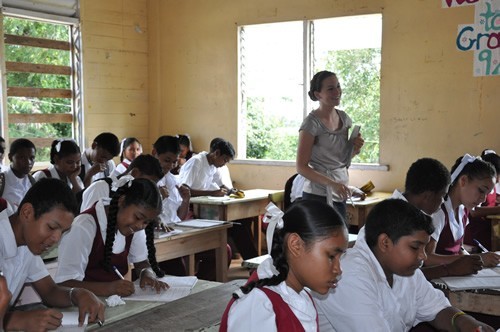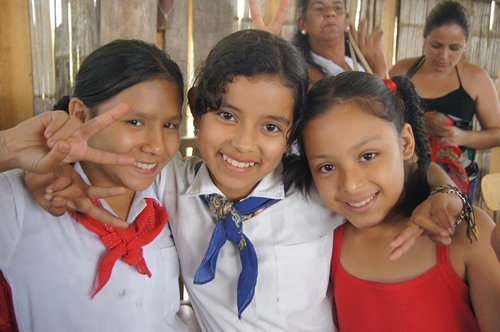How to Find the Right Volunteer
Programs in South America
By Volker Poelzl
Resources updated 9/4/2023 by Transitions Abroad
 |
| WorldTeach volunteer with students
in Guyana. Photo courtesy of Worldteach. |
South America is a continent with many
needs. There is widespread poverty, social injustice, violence,
and environmental degradation. Since the end of the long
rule of military dictatorships on the continent during the
1980s, civil society has returned as a major player in helping
to relieve some of South America’s most pressing problems.
As a result, there are a large number of NGOs and volunteer
service organizations all over the continent involved in
helping the development of their countries. These organizations
perform a huge variety of tasks, from protecting animals
and ecosystems to providing vaccinations to indigenous tribes
and teaching art to poor urban children. If you are interested
in volunteering in South America, you will discover that
opportunities are not lacking. You will find a large variety
of different work experiences to suit your interests.
Where Should You Volunteer
in South America?
The choice of country depends on a variety
of factors:
- Although one purpose of volunteering
is to assist the local organization you are working for,
you should place primary consideration on the people
you are helping, consider your personal needs, interests,
and preferences. If you’ve always wanted to go
to Brazil, then why not volunteer there? If you speak
Spanish, why not volunteer in one of South America’s
Spanish-speaking countries?
- You should also keep in mind logistics
and finances. Consider the cost of air travel and the
cost of living at your destination before making a decision.
Living and volunteering in a city will be much more expensive
than volunteering in a small town or in the countryside.
The cost of travel and the cost of living in urban areas
in Brazil and Argentina are much higher than in rural
areas in Peru, Ecuador or Bolivia, for example.
- Logistical considerations such as
travel time to your destination, housing, local transportation,
and contact to the outside world are also factors you
should keep in mind.
- If you depend on high-speed internet
to Skype or chat with your friends and family at home,
you might want to consider an urban area, where high-speed
internet access is more likely.
- If you volunteer at a remote animal
reserve in the Amazon, you will most certainly have none
of the usual forms of entertainment or nightlife available
to you.
- Weather, climate, and the ecosystem
are other important factors to consider. If you don’t
like the cold, don’t volunteer in the Bolivian
highlands in winter. Likewise, if you can’t handle
mosquitoes, tarantulas, and other kinds of creepy-crawlies,
you should stay away from the Amazon. Not a day went
by in my year and a half in the Brazilian Amazon that
I did not come across a small creature that could cause
considerable harm to humans, especially in rural areas,
where medical attention is sparse.
What Type of Work is Available
in South America?
As mentioned before, there are a large
number of volunteer opportunities all over South America.
You will find work in:
- teaching/education
- health care
- social services
- childcare
- AIDS prevention
- social justice
- human rights
- environmental protection
- preservation work
- animal care
- administrative work
- and many more types of work or service
For example, you could:
- Work for an organization to provide
health services to indigenous communities in Argentina.
- Build houses for homeless migrants
in the Brazilian Northeast.
- Help street children in Rio de Janeiro.
- Provide AIDS/HIV education for indigenous
women in Bolivia.
- Help preserve rare rain forest species
in Ecuador.
- Work with river dolphins in the
Peruvian Amazon.
- Help with earthquake relief in Chile
 |
| WorldTeach students in Costa
Rica. Photo courtesy of Worldteach. |
Volunteer jobs are available with both
public and non-profit organizations. Management style and
administrative/management structure vary considerably from
one organization to another. As a general rule, public service
agencies tend to be more structured and bureaucratic, while
small NGOs tend to be the opposite: spontaneous, democratic,
but often lacking structure and planning, sometimes making
it more difficult for volunteers to find their place in
the organization.
My experience is that it is more important
to find work you enjoy than to find the perfect organization
which might do everything the way you think best. If you
enjoy your work it is easier to cope with minor organizational
flaws.
How Can I find a Reputable Volunteer
Organization or Placement Service?
There are many organizations for volunteers
in South America, and it should not be difficult for you
to find a position that fits your interests and needs. There
are several different ways to find a volunteer position
in South America:
- The easiest way is to book a volunteer
vacation with a reputable U.S.-based or international
placement organization. These companies refer top-notch
volunteer placements with renown international organizations
(among them the WWF–World
Wildlife Fund and many of these South
American organizations or organizations with programs
in South America), but some of them charge very high
fees which cover the legitimate requirements and concerns
of volunteers in far-away locations which can sometimes
be a financial burden for students and would-be volunteers
in today’s fragile economic environment.
- There are alternatives to expensive
volunteer programs. If you are a little
adventurous, you can find volunteer work on your own
by contacting a South American NGO or organization directly
via www.volunteersouthamerica.net.
This is much cheaper than booking a volunteer placement
with an organization, but you may have to find your own
lodging, and there likely will not be as much support,
training, and other services compared to larger placement
organizations. If that’s the way you want to go,
I recommend that you go with some knowledge of the local
language. Instead of searching for volunteer opportunities
online without any prior experience or recommendations,
it might be a good idea to contact reputable international
charity, aid, environmental preservation, and human rights
organizations that are active in South America. They
may be able to recommend volunteer opportunities for
you, since they have wide-spread contacts all over the
continent.
The Cost Factor
Volunteer program costs vary widely,
and the more research you do, the better you will understand
the pricing differences.
-
There are many relatively costly volunteer projects
in cooperation with large U.S. or international organizations
that charge several thousand dollars per month to participate and include many options to make your experience go smoothly.
-
There are medium-priced volunteer
opportunities. For example, you can volunteer doing conservation on the
famous Galapagos Islands for about US$900
for two week, which may include fewer options.
-
Finally, very inexpensive volunteer work exchange programs with a host can be arranged for a very small fee to cover your room and board through organizations such as Worldpackers, Helpx.net, and Idealist.org.
For example, the very reputable Amigos
de Américas includes roundtrip airfare, local
transportation, food, lodging, health insurance, supervision,
orientations, etc. in the fee for their 7-week South
America volunteer programs (participants can either pay
or individually fund raise the amount).
A Broader View Volunteers is a 501(c)3 charity and offers lower-cost volunteer service trips and immersive
travel in South America while providing many services. Programs are available for retirees, families, teens and those who want to make their travels
meaningful.
Sarah and Oliver Ehlers, Founders of ABV Volunteers, say “We created programs that reflect how we
love to travel with culturally immersive activities, homestays/guesthouses and a commitment to support the local community. Our volunteer programs open the mind of our travelers, deepens their understanding
of the world around them and introduces them to a new culture.”
By contrast, small volunteer programs typically include food, local transportation, and perhaps lodging at a homestay at most.
The more you research the various options
for volunteering, the better you will be able to find a
program that you like, appeals to your needs, and that you can afford.
When is the Best Time to Go?
Seasons are reversed in most of South
America (south of the equator), which makes our summer their
winter. But in the tropics such as the Amazon there are
really only two seasons: the dry season, roughly from June
to October, and the rainy season from November to May. The
rainy season is hot and incredibly humid, and the dry season
is hot and dry. The Andean mountains have a continental
climate with large temperature changes between seasons.
Summers are warm at high altitudes, but winters are quite
cold. If it is important for you to work and live in a climate
that you enjoy and in which you are comfortable, plan a
volunteer stay around your favorite time of year in the
country of your interest.
In terms of work opportunities, there
is no real difference between seasons, since NGOs, government
and aid organizations are active year-round. One exception
is animal preservation work that is sometimes seasonal.
If you help to preserve dolphins, whales or river turtles,
the preservation work follows the life cycle of the animals.
For example, preservation work with river turtles in the
Amazon is most active, when the turtles start laying their
eggs on sandy riverbanks at the beginning of the dry season
(June-July).
 |
| Country view in Colombia. Photo
courtesy of Worldteach. |
What Are the Requirements to
Volunteer in South America?
Some volunteer positions require basic
Spanish or Portuguese language skills or certain fundamental
educational or professional experience, but most organizations
are happy to receive any help they can get, and they will
accept almost anyone interested in working for them. Some
volunteer programs also have a required minimum stay due
to the extent of the training or the type of work involved.
Nonetheless, if you are willing to volunteer for at least
two weeks, you should find a position without a problem.
Keep in mind that a basic health exam
or health insurance policy may be required for some volunteer
activities, since aid organizations and NGOs don’t
want to be responsible for your health care expenses should
you fall ill. There are also visa requirements that differ
from country to country. Many volunteers enter as tourists
and extend their tourist stay if their volunteer opportunity
lasts longer than expected. However, most South American
countries officially require volunteers to get a specific
volunteer visa. Just make sure you don’t give immigration
officials the misleading answers if you enter South America
as a tourist with the intent to work as a volunteer.
What Are the Local Working Conditions
Like?
Working conditions depend both on the
location of your volunteer position and the financial situation
of the organization for whom you are working:
- An organization or placement service
that charges a high fee to volunteers usually assures
that their participants are lodged comfortably and that
they have basic services available to them, such as internet
access, electricity (air conditioning), and telephone
access. Health insurance, orientations, local transport,
and excursions may also be included.
- If you work for a small, under-funded,
local organization, you may not be charged any fees,
but working conditions may be much more unpredictable.
When I participated in a volunteer project through my
university in Rio de Janeiro, volunteers were simply
told to go the community center in a nearby shantytown
and set up our own art, music, and English
classes for the local children. Due to the lack of support,
not many of us foreign exchange students lasted through
the school year.
The location of your placement is another
important factor that impacts working conditions:
- Much volunteer work is available
in urban areas, where the need is greatest and where
there is often the largest concentration of NGOs. Volunteers
have the benefits of enjoying city life and city amenities.
But working in impoverished neighborhoods in South American
cities can also be more stressful and occasionally even dangerous.
- Working in rural areas, on the other
hand, tends to be a more peaceful and less stressful
experience, but volunteers often lack many of the basic
amenities to which they are accustomed.
In sum, before finalizing your choice,
make sure you find out as much about the local working conditions
as you can, since they can easily spoil your volunteer vacation
or, on the other hand, turn it into an experience of a lifetime.
For more information and a list of articles
by participants along with many major programs and resources,
check out the many options for Volunteering
in South America.
Volker
Poelzl is a Living Abroad
Contributing Editor for TransitionsAbroad.com. He
studied and volunteered in Brazil and has traveled
in six South American countries.
|
